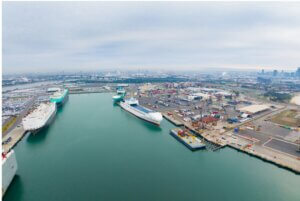Port Capacity Enhancement Program
Project overview
As part of the Port of Melbourne’s stewardship obligations, it is required to ensure that port capacity can meet the future demands of Victoria’s growing economy. The Port of Melbourne is engaging about the next stage of that port capacity, called the Port Capacity Enhancement Program (PCEP).

This program was outlined in the Port of Melbourne’s 2050 Port Development Strategy (PDS) and involves developing a Webb Dock North container terminal and securing the long-term future for the Tasmanian trades.
Once delivered the PCEP will ensure the Port of Melbourne (PoM) continues to play a significant role in driving forward the Victorian economy.
Engagement
PoM is committed to stakeholder engagement that is inclusive, timely, genuine and transparent. Our approach is guided by our commitment to comply with our regulatory obligations, and our intent to listen to and be responsive to our stakeholders. We will always seek opportunities to strengthen our engagement over time in line with the Pricing Order Engagement Protocols.
We recognise that engaging stakeholders in our planning process for PCEP leads to informed decision-making that balances the needs and interests of relevant parties.
Stage One – Technical reports
In September 2022 PoM began a process to collect feedback on three technical reports as the key drivers of the project. Since this time, a robust engagement program has captured feedback from stakeholders on three technical reports, assumptions and scenarios, which have been used to inform technical analysis, as well as providing insights on a number of other topics.
Final versions of the reports including an engagement summary report can be viewed by clicking the below:
- Deloitte – Port of Melbourne Trade Forecasts Summary Report & Sensitivity Analysis (September 2023)
- GHD – Port of Melbourne Future Containership Fleet Analysis, 2023-2050 (September 2023)
- Black Quay – Port of Melbourne Container Capacity Review Final Report (September 2023)
- PCEP Stage One Engagement Summary Report (September 2023).
The table below highlights feedback incorporated into to the final technical reports.
| Key changes to each report | |
| Trade demand | The following changes were included in the June 2023 forecast:
|
| Ship fleet | The following changes were included in the July 2023 forecast:
|
| Container Capacity Review | Since February 2023, we have been collecting feedback on capacity, most notably with stevedores. As a result, changes have been incorporated into the final September 2023 Container Capacity Review with scenarios updated reflecting feedback relating to: |
We thank all of our stakeholders for their feedback and participation. On 21 September 2023 PoM closed out the PCEP Stage One engagement program.
Stage Two – Cost Benefit Analysis
Since closing Stage One engagement, PoM has adopted Scenario B4 from the Black Quay Container Capacity Review Final Report 20 September 2023, as the base case to inform the draft Cost Benefit Analysis (CBA).
On page 83 of the Black Quay report Scenario B4 intercepts with Trade – Baseline case in 2037 and forms the basis of the draft CBA.
Delivery timing
Port of Melbourne is targeting new capacity at Webb Dock North in 2036, to avoid capacity constraints that forecasting suggests may first arise in 2037.
Targeting 2036 for additional capacity has been informed by stakeholder engagement, analysis of tenant impacts and assessment of delivery schedules.
This proposed timing balances meeting demand for the benefit of Victoria and impacts on the broader supply chain.
There is significantly more work to be done across all elements of new capacity planning, and we look forward to further refining our program and engaging with our stakeholders.
We are currently planning the engagement approach to gain insights on a PCEP draft Cost Benefit Analysis with consideration for feedback received during Stage One engagement. We will notify stakeholders when information is available on next steps and timing.
